Vol 8 No 4 2023 – 30
Nemat A. Muhsen1* and Mustafa A. Al-Dossary1
1University of Basrah, College of Science, Department of Ecology
*Corresponding author:email: mustafa.najem@uobasrah.edu.iq
Available from: http://dx.doi.org/10.21931/RB/2023.08.04.31
ABSTRACT
Fungi are one of the most important groups of microorganisms in the environment, and due to their ability to produce several types of enzymes, they play an essential role in the environment. During this study, fourteen species of fungi were isolated from fifteen soil samples collected from several agricultural areas in Basrah Governorate, southern Iraq, and their enzymatic activity was tested for four extracellular enzymes (cellulase C, laccase La, lipase Lp, and manganese peroxidase Mp) on specific solid media. The isolated fungi showed good enzymatic activity, in which 12 fungal species can secret manganese peroxidase, 11 can secret cellulase, 9 can secret lipase, and five can secret laccase enzyme. Aspergillus candidus and A. versicolor showed a positive detection for all enzymes, Cladosporium showed positive detection for C, Lp, and Mp, while Mucor sp. showed negative detection for all enzymes.
Keywords: Enzymatic activity, Fungal diversity, soil.
INTRODUCTION
Fungi play an essential role in the decomposition process of organic substances by enzyme secretion, such as (cellulase, laccase, lipase, and manganese peroxidase). The microbes need to produce an extracellular enzyme to convert polymeric compounds such as cellulose, lignin, starch, pectin, and other components into smaller molecules that can be assimilated easily 1.
Many researchers have tended to exploit these compounds to produce simple saccharides of industrial importance, such as biofuel production, beverage, confectionery, textile, and leather. They are also used in the biological treatment of organic and inorganic pollutants using the enzymes produced by fungi. There are different types of fungal enzymes involved in this process, such as cellulase enzyme, which is capable of decomposing cellulose into glucose 2; the laccase enzyme can break the lignin that gives the wood its added firmness additionally, it breaks down aromatic hydrocarbon molecules 3, lipase enzyme stimulates several chemical reactions for the hydrolysis of fats, which are crucial components of agricultural and oil waste 4, and manganese peroxidase enzyme which is secreted mainly by white rot fungi and play a dynamic role in the polymerization and depolymerization of lignin and the oxidation of phenolic and non-phenolic compounds 5.
The degradation of all organic and agricultural substances depends on the presence or the absence of enzymes secreted by the microorganisms and the strength of the enzymes themselves 6. These extracellular enzyme systems secreted into their surrounding environment allow the fungi to grow on various natural and artificial substrates, where they break down a variety of substrates into small molecules that may be taken up and digested by their cells 7.
The present study investigated the diversity of fungi in some agricultural soil and evaluated their ability to secrete cellulase, lipase, laccase and manganese peroxidase enzymes.
MATERIALS AND METHODS
Sampling sites
Fifteen soil samples were collected from various agricultural locations in the Basrah Governorate. These areas include Abu Al-Kasib, Garmah Ali and Alqurna. These locations have different plant types ranging from date palms to vegetables. 250 g of agricultural soil was taken from the soil each time. Each sample was taken from other locations and mixed to form one homogenized sample.
Isolation and identification of fungi
Dilution plate method 8, was used to isolate fungi from fifteen soil samples collected from various agricultural locations in the Basrah Governorate, in which 10 g of soil were diluted in 90 ml Distilled water to make a dilution of 10-1. Potato dextrose agar medium (PDA) supplemented with 250 mg/l chloramphenicol antibiotic was used for the cultivation and isolation of fungi from the diluted soil samples; it was prepared according to the direction of the manufacturing company (Hi-Media, India). The cultures were incubated at 25 °C and examined first after 3-4 days from incubation to see the fungal hyphae, and they were further set for one to two weeks.
The isolated fungi were first tested under the dissecting microscope. Then, slides were prepared from the isolated fungi and stained with lactophenol cotton blue dye to see the microscopic features of each fungal isolate under the compound microscope. The isolated fungi were identified according to the following 9, 10, 11, 12, 13.
The percentage of occurrence for the isolated fungi was recorded according to the following equation:

Evaluation of the enzymatic activities of the isolated fungi
The enzymatic activity was evaluated using special media; pure cultures from all fungal isolates were first activated on a PDA medium for one week at 25 °C. Then, a disk was taken by a cork borer 5 mm from the edge of each fungal isolate and used to inoculate the center of the media to study the enzymatic activity for each enzyme as follows.
Cellulase enzyme
Carboxymethyl cellulose medium (CMC) was used to evaluate the ability of the isolated fungi to secret cellulase enzyme; this medium contained g/l: 1g K2PO4, 0.5g KCL, 2g NaNo3, 0.5g MgSO4: 7H2O, 2g carboxy methyl cellulose, 20g agar and 1L distilled water 14. After 3-7 days of incubation at 25 °C, the plates were flooded with 0.2% aqueous Congo red solution and distained with 1M NaCl for 15 minutes. The appearance of yellow areas around the fungal colony indicates positive activity; otherwise, the red medium shows harmful activity. 1.
Lipase enzyme
Peptone agar medium was used to evaluate the ability of the isolated fungi to secret lipase enzyme; the composition of this medium was g/l: 10g peptone, 5g NaCl, 0.1g CaCl.2H2O, 20g agar and 1L distilled water; pH6.0 supplemented with 1% Tween 20 separately sterilized by filtration using Millipore filter paper 0.45 µm and added to the medium. After seven days of incubation at 25 °C it was observed that some fungal isolates formed visible precipitation around the colony due to the formation of calcium salts of the lauric acid liberated by the enzyme, which indicated positive lipase activity of the fungi, while others didn’t form any precipitation which means hostile activity 1.
Laccase enzyme
The ability of fungi to secret laccase enzyme was evaluated by using Glucose yeast extract peptone agar medium containing g/l: 20g glucose, 5g yeast extract,10g peptone, 20g agar and 1L distilled water and supplemented with 0.05g α-naphthol, pH 6.0. After seven days of incubation at 25 °C, it was observed that only the fungal isolate, which has a positive ability to secrete laccase enzyme, turns the colorless medium into dark due to the oxidation of α -naphthol by laccase enzyme 1.
Manganese peroxidase enzyme
The ability of fungi to secret manganese peroxidase enzyme was evaluated by using Czapek-dox agar medium, which was prepared according to the direction of the manufacturing company (Hi-Media, India), and then supplemented with phenol red dye at a concentration of 0.0025%. After seven days of incubation at 25 °C, it was observed that some fungal isolates turned the color of the medium from red to yellow, which indicates a positive reaction, and the isolate can secret manganese peroxidase enzyme; otherwise, red medium indicates negative activity 15.
Statistical analysis
The ANOVA analysis was used by applying Minitab ver.16 to statistically analyze the results of the fungal enzymatic activity. The mean was tested using the least significant difference RLSD test under the probability level 0.01.
RESULTS AND DISCUSSION
Fungal identification
Fourteen isolates were counted from fifteen agricultural soil samples (table 1). These belong to 8 fungal genera in addition to sterile mycelia. Thirteen species from them, with 92.85 % percentage of occurrence, belonged to ascomycota either in their anamorphic state with 12 species or with its telemorphic state with only one species, Chaetomium sp. in the second place came the zygomycota with only one species Mucor sp. and 7.1 % percentage of occurrence.
The appearance of the ascomycetes fungi with their anamorphic state in high percentage was due to their ability to produce many reproductive units. This allows them to spread quickly in the environment. Also, they can secrete different types of enzymes, enabling them to use other materials in the environment for growth. Besides, they can tolerate the stress in the atmosphere; these features allow them to be one of the most widespread groups of fungi in the environment 16, 17, 18, 19.
The number of isolated fungi in this study seems to be low compared to the other studies; this may be due to the high temperatures during the time of sample collection, which may reach 50 °C, which negatively affects the growth of fungi in the environment. In general, the differences in the percentages of appearance of fungal genera may be due to their ability to tolerate and adapt to extreme conditions, their adaptation to a wide range of temperatures and their ability to secrete different types of enzymes that enable them to decompose various materials and exploit them as a source of energy and growth, in addition to their ability to produce a large number of reproductive units which enable them to spread in the environment 20.
The percentage of occurrence of species ranged from 7.1%, like Alternaria sp. and Bipolaris sp., to 57.1 % in Aspergillus niger; most of the isolated species belonged to the genus Aspergillus with 7 species. This genus has high enzymatic activity and produces large quantities of reproductive units, which enable its species to adapt very well to their environment. It can grow and widely spread in the environment 12.
This result is consistent with other studies in which the Ascomycetes and the genus Aspergillus represent the most isolated fungi 21,22,23, 24.
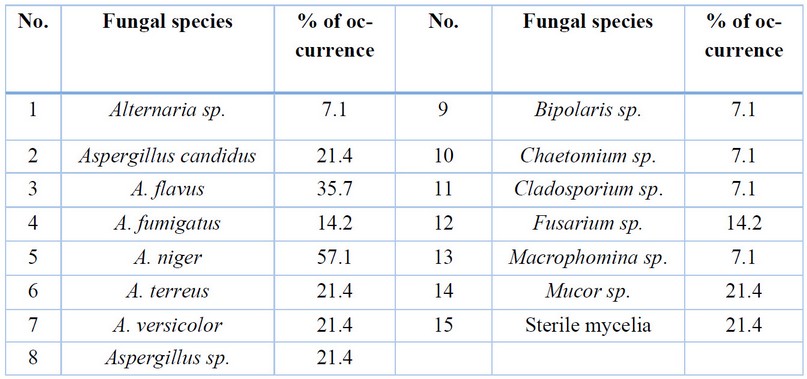
Table 1. The isolated fungi with their percentage of occurrence
Enzymatic activity
The enzymatic activity of 14 fungal species isolated from agricultural soil was evaluated to study their ability to secrete cellulase, laccase, lipase and manganese peroxidase enzymes.
However, there is an evident variation between the different fungal isolates in terms of their enzymatic abilities; the results showed that there were significant differences between the other fungal species in their enzymatic activity, whether between the species belonging to one genus or between species of different genera in terms of the number of enzymes that each fungus was able to secrete and the quantity of its secretion. The isolates showed diverse levels of enzymatic activity, and this may be due to the enzymatic capacity that differs from one species to another according to its adaptation to the environment in which it lives and the inherent enzymatic activity of each fungus, in fact, in the atmosphere each fungal species possesses an enzymatic capacity that distinguishes it from other. 1, 25
The results showed that the tested fungi could secrete from one to four different types of examined enzymes except the Mucor sp., which was unable to secrete any enzymes. In comparison, the species Aspergillus candidus and A. versicolor were able to secrete all four types of enzymes but in varying ability.
In general, when some species appear to have a negative result, this doesn’t mean they don’t have any enzymatic activity. It may refer to either it producing an enzyme but doesn’t liberate from the hyphae or it produces and liberates. Still, the medium limits enzyme secretion; therefore, the negative results do not represent an absolute confirmation of the species’ inability to make the specific enzyme 26.
Most of the studied fungi were able to secrete manganese peroxidase enzyme, and 12 species of fungi were able to secret it, but with different capabilities; it gave a positive reaction by changing the color of the medium from red to yellow due to the transformation of phenol aromatic ring. The significant change in color of the media refers to the greater secretion of this enzyme by the fungus with different capabilities of secretion rates from low as in Alternaria sp., to high secretion as in Aspergillus candidus (Table 2, Fig.1).
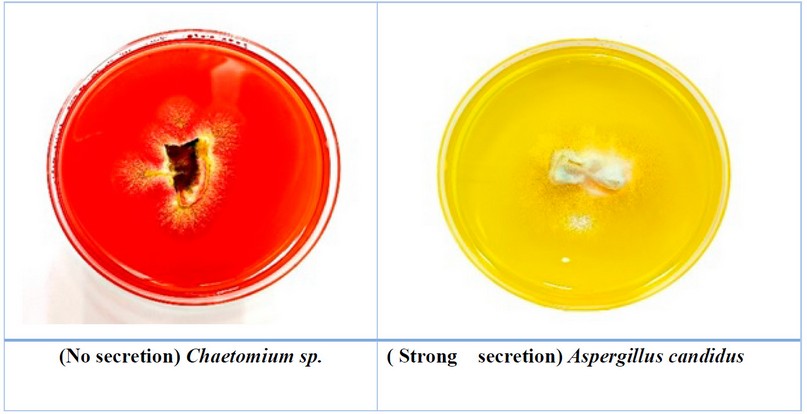
Figure 1. The ability of some fungi to secret manganese peroxidase
The fungi that can secrete this enzyme are distinguished by their ability to decompose complex pollutants and convert them into substances used as a source of energy and carbon25.
Numerous fungi possess the manganese peroxidase enzyme, a part of the ligninolytic, extracellular enzymatic system primarily responsible for degrading lignin. It can also degrade organic pollutants and is a commonly used enzyme in converting toxic environmental contaminants into less toxic ones. Therefore, the manganese peroxidase enzyme plays an essential role in the biological activity of fungi due to its ecological importance and fungi that can secrete this enzyme are distinguished by their ability to decompose complex pollutants and convert them into substances used as a source of energy and carbon 27. This result is consistent with the study of 28. who has found that most of his fungal isolates could secrete this enzyme.
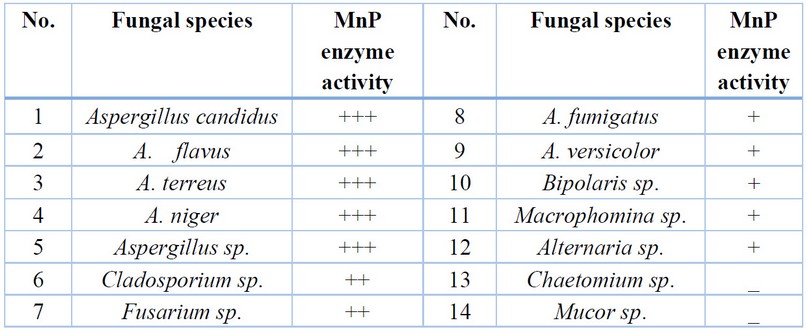 _
_– No color change, + Simple color change, ++ Medium color change, +++ Strong color change
Table 2. Fungal enzymatic activity for manganese peroxidase enzyme
The cellulase enzyme came in second place, with 11 fungal species reacting positively by forming a yellow halo around the fungal colony due to the degradation of complex carbohydrates into simple sugars.
The widest halo refers to the ability of fungi to secret the enzyme. The rat secretion rates went from low, as in Macrophomina sp., to high secretion, as in Cladosporium sp. (Table 3, Fig.2). The results of statistical analysis showed significant differences (P<0.01) between the tested fungi in their ability to produce cellulase enzyme. A large number of microorganisms are involved in the degradation of cellulose.
However, the cellulase enzyme plays a significant role in the biological activity of fungi, and they are still one of the most essential microorganisms in cellulose degradation. It has an extracellular enzyme system that breaks down cellulose into glucose that dissolves in water and can be used as a source of energy. So, it’s played an essential role in decomposing plant waste, in which cellulose forms approximately 94% 29.
This result agrees with the study of 30, which showed nineteen species of fungi to grow on a cellulose medium.
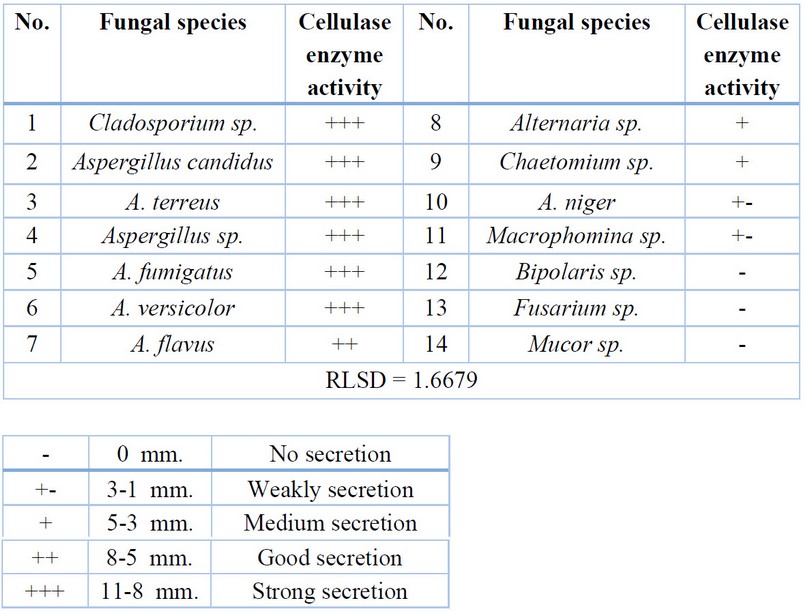
Table 3. Fungal enzymatic activity for cellulase enzyme
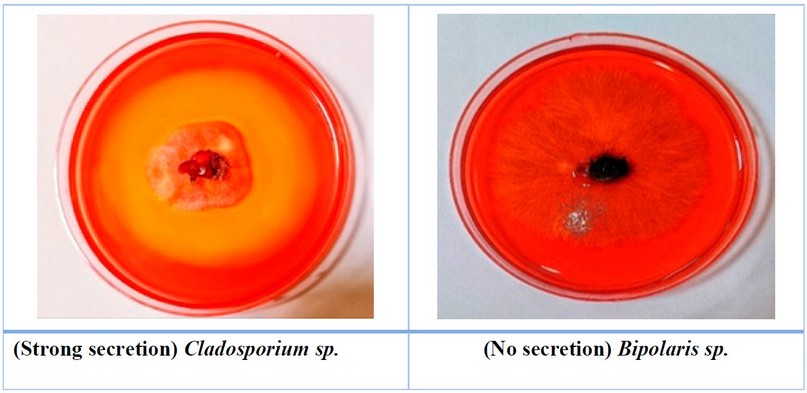
Figure 2. The ability of some fungi to secret cellulase enzyme
The lipase enzyme came in the third level, in which nine fungal species achieved excellent efficiency in the secretion of this enzyme by forming a transparent halo around the fungal colony due to the formation of a white precipitate or white crystals.
The ability to produce lipase enzyme appears with different capabilities of secretion rates from low as in Chaetomium sp., to high secretion, as in Cladosporium sp. (Table 4, Fig.3). The results of statistical analysis showed significant differences (P<0.01) between the tested fungi in their ability to produce lipase enzyme.
Several studies indicate the fungal ability isolated from agricultural soil to produce lipase enzymes like 28, 32. And many fungi can secrete this enzyme, and this may be because lipase is a fatty substance found in grains and agricultural materials and can be used by fungi easily as a nutritional source for growth, which contributed to the increase in the number of fungi that were able to produce this enzyme, soils may also contain fatty substances in the organic content of the soil, and microorganisms including fungi, have an important role in the degradation of fatty substances through the secretion of extracellular lipase enzyme 31.
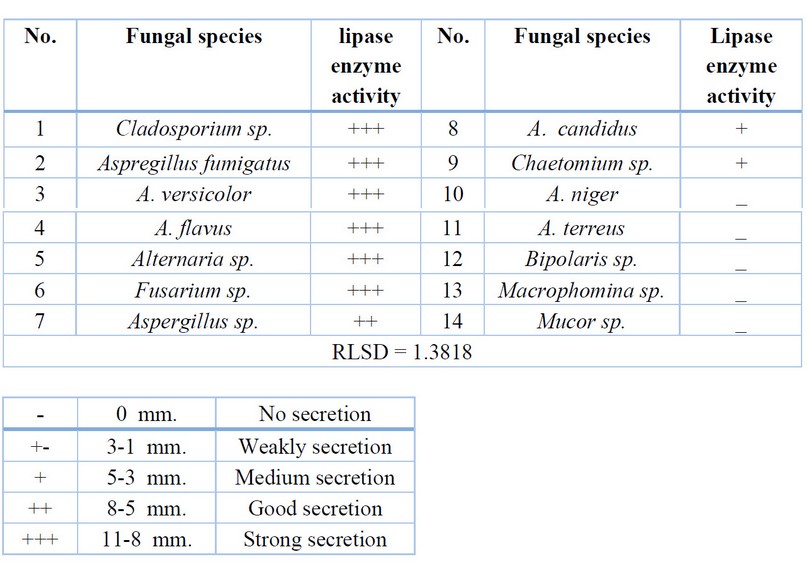
Table 4. Fungal enzymatic activity for lipase enzyme
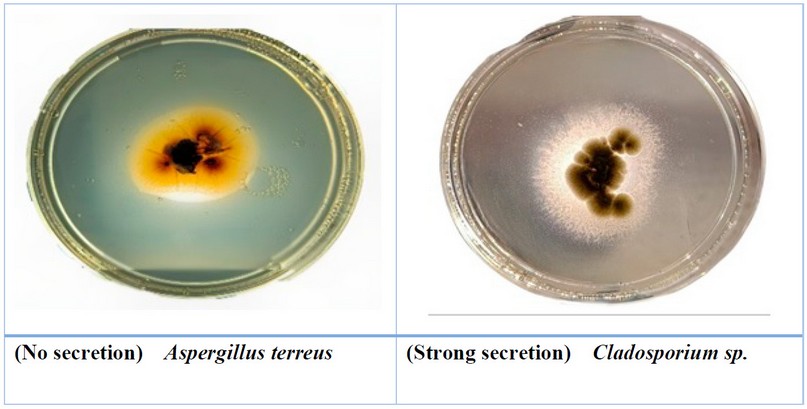
Figure 3. The ability of some fungi to secret lipase enzyme
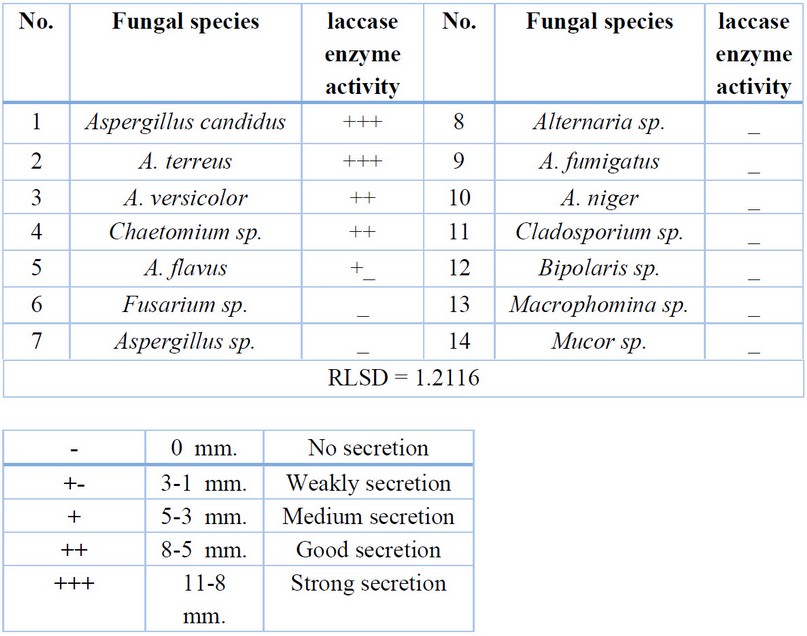
Table 5. Fungal enzymatic activity for laccase enzyme
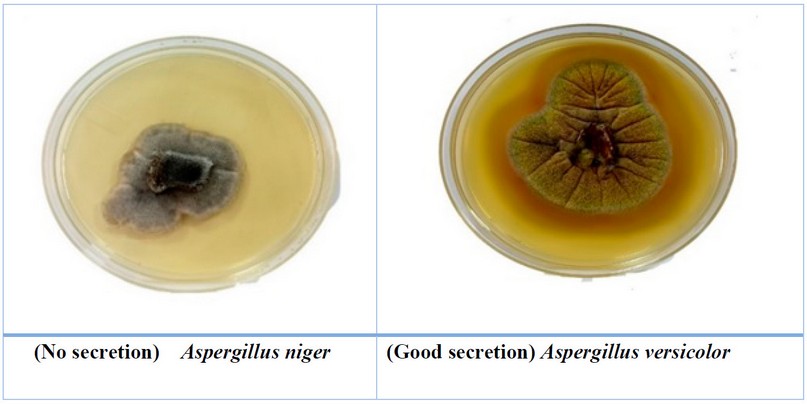
Figure 4. The ability of some fungi to secret the Laccase enzyme
Five isolates only secrete the laccase enzyme; Aspergillus candidus and A. terreus fungi had the best secretion for this enzyme, while the other three fungi produced it in very small or medium quantities Table 5, Fig. 4. The results of statistical analysis showed significant differences (P<0.01) between the tested fungi in their ability to produce laccase enzyme.
The laccase enzyme plays a key role in the degradation of pollutants in the environment due to the activity of free radicals during the oxidation of aromatic compounds, phenolic compounds and amines, and this enzyme is used in biotechnology applications as a biocatalyst and basidiomycetes are the best in its secretion 33. In recent years, some studies have shown that some anamorphic fungi could secrete this enzyme, which may be due to the mutations resulting from the nature of the environment in which the fungi live 34.
This is consistent with the findings of 35, which found that very few fungi can secrete this enzyme in his study. It also agreed with the study of 22, which found only five species of fungi can secrete laccase enzyme.
CONCLUSIONS
In conclusion, the study found that the ascomycetes fungi, particularly the genus Aspergillus, were the most isolated in the agricultural soil samples. These fungi have high enzymatic activity and the ability to secrete many reproductive units, allowing them to adapt well to their environment and spread widely. Additionally, the study showed that the tested fungi had varying abilities to secrete different types of enzymes, with the manganese peroxidase enzyme being the most commonly secreted, followed by cellulase, lipase, and laccase enzymes. These enzymes play important roles in the environmental degradation of pollutants and organic materials.
Conflicts of Interest: “The authors declare no conflict of interest.”
REFERENCES
1. Sunitha VH, Nirmala Devi D, Srinivas C. Extracellular enzymatic activity of endophytic fungal strains isolated from medicinal plants. World J. Agric. Sci. (2013); 9(1): 1-9.
2. Pascual AR, Martín ME. Cellulose. Intech Open. (2019); 22- 92.
3. Sun K, Li S, Si Y, Huang Q. Advances in laccase-triggered anabolism for biotechnology applications. Crit. Rev. Biotechnol. (2021); 41(7): 969-993.
4. Kavitha K, Shankari K, Meenambiga S S. A review on extraction of lipase from Aspergillus Species and its applications. RJPT. (2021); 14(8):4471-4475.
5. Chowdhary P, Shukla G, Raj G, Ferreira LFR, Bharagava R N. Microbial manganese peroxidase: a ligninolytic enzyme and its ample opportunities in research. SN Appl. Sci. (2019);1: 1-12.
6. Akhtar N, Mannan M A U. Mycoremediation expunging environmental pollutants. Biotechnol. Rep. (2020); 26: e00452.
7. Benguenab A, Chibani A. Biodegradation of petroleum hydrocarbons by filamentous fungi (Aspergillus ustus and Purpureocillium lilacinum) isolated from used engine oil contaminated soil. Acta Ecol. Sin. (2021); 41(5): 416-423.
8. Wicklow D T, Whittingham W F. Soil microfungal changes among the profiles of disturbed conifer‐hardwood forests. Ecol. (1974); 55(1): 3-16.
9. Raper K, Fennell DI. The genus Aspergillus. Sec. ed. Robert Krieger Pybl. New York. (1973): 686 pp.
10. De Hoog G S, Guarro J. Atlas of clinical fungi. CBS Netherland and university at Rovira Virgili. Spain. (1995): 720pp.
11. Sakagami Y, Watanabe R, Aoyama C, Matsunaga S, Higaki N, Fujimura K. The intelligent ASIMO: System overview and integration. IROS. September 2002; (3): 2478-2483.
12. Sheifert K, Jones G M, Games W, Kendrick B. The genera of hyphomycetes in Netherland. CBS-KNAW fungal biodiversity center Utrecht. 2011; pp. 485.
13. Guarro J, Gene J, Stachigel AM, Figueras J. Atlas of soil Ascomycetes in Netherland. CBS-KNAW fungal biodiversity center Utrecht. (2012); 997pp.
14. Ireri N, Hamadi B I, Wanjiru W, Kachiru R. Characterization, enzymatic activity and secondary metabolites of fungal isolates from lake Sonachi in Kenya. J. Pharm. Biol. Sci. (2015); 0(2):65-76.
15. Ali M I, Khalil N M, El-Ghany M N A. Biodegradation of some polycyclic aromatic hydrocarbons by Aspergillus terreus. Afr. J. Microbiol. Res. (2022); 6(16): 3783-3790.
16. Laich F, Vaca I, Chavez R. Rhodotorula portillonensis sp. nov., a basidiomycetous yeast isolated from Antarctic shallow-water marine sediment. Int. J. Syst. Evol. Microbiol. (2013); 63(Pt_10): 3884-3891.
17. Al-Saadoon A H, Al-Dossary M N. Fungi from submerged plant debris in aquatic habitats in Iraq. Int. J. Biodivers. Conserv. (2014); 6(6): 468-487.
18. Alrumman S A, Standing D B, Paton G I. Effects of hydrocarbon contamination on soil microbial community and enzyme activity J. King Saud Univ. Sci. (2015); 27(1): 31-41.
19. Altaee M S, Al-Dossary M A A. Evaluation of the enzymatic activity of some fungi isolated from plastic contaminated soils and their LDPE biodegradation ability. MRS Bull. (2021); 16(2).
20. Taylor D L, Sinsabaugh R L. The soil fungi: occurrence, phylogeny, and ecology. Soil microbiology, Biochem. Syst. Ecol. (2015);4: 77-109.
21. Al-Saadoon A H, Al-Dossary M A. Some fungi isolated from submerged plant debris in southern Iraq. . MRS Bull. (2010);5(2): 207-221.
22. Ali F T, Al-Dossary M A W. Study for the enzymatic activity of some fungi isolated from agricultural soil. MRS Bull. (2019);14(1).
23. Al-Dossary M A W, Dahir A A. Bioethanol production from corn and barley wastes by Aspergillus flavus. MRS Bull. (2023);18(1).
24. Al-hamdani R R, Al-Dossary M A. Investigation the Degradation Capabilities of Fungal Isolate from Water and Sediment Samples to Congo Red Dye. Asian J. Environ. Sci.(2023);16(2).
25. Patil M G, Pagare J, Patil S N, Sidhu A K. Extracellular enzymatic activity of endophytic fungi isolated from various medicinal plants. Int. J. Curr. Microbiol. App. Sci. (2015); 4(3): 1035-1042.
26. Jaiboon K, Lertwattanasakul N, Limtong P, Limtong S. Yeasts from peat in a tropical peat swamp forest in Thailand and their ability to produce ethanol, indole-3-acetic acid and extracellular enzymes. Mycol. Prog. (2016);15: 755-770.
27. Usha K Y, Praveen K, Reddy B R. Enhanced production of ligninolytic enzymes by a mushroom Stereum ostrea. Biotechnol. Res. Int. 2014.
28. Steudler S, Werner A, Walther T. It is the mix that matters: Substrate-specific enzyme production from filamentous fungi and bacteria through solid-state fermentation. Solid State Fermentation: Int. j. Eng. Res. Appl. (2019); 51-81.
29. Maruyama C R, Bilesky-José N, de Lima R, Fraceto L F. Encapsulation of Trichoderma harzianum preserves enzymatic activity and enhances the potential for biological control. Front. Bioeng. Biotechnol. (2020); 8: 225.
30. Jumaah E M, Al-Saadoon A H, Al-Dossary M A. Enzymatic activity of some fungi isolated from submerged plant parts in aquatic habitats southern Iraq. MRS Bull. (2020); 15(2).
31. Bellaouchi R, Abouloifa H, Rokni Y, Hasnaoui A, Ghabbour N, Hakkou A, Asehraou A. Characterization and optimization of extracellular enzymes production by Aspergillus niger strains isolated from date by-products. JGEB. (2021); 19(1): 1-8.
32. Sopalun K, Iamtham S. Isolation and screening of extracellular enzymatic activity of endophytic fungi isolated from Thai orchids. S. Afr. J. Bot. (2020); 134: 273-279.
33. Benitez S F, Sadañoski M A, Velázquez J E, Zapata P D, Fonseca M I. Comparative study of single cultures and a consortium of white rot fungi for polychlorinated biphenyls treatment. J. Appl. Microbiol. (2021); 131(4): 1775-1786.
34. Han M, Yang J, Ma J, Wang C, Chen S, Xu M, An Q. Extracellular laccase activity among Ganoderma and Coriolopsis species grown on lignocellulosic wastes. Bioresour. Technol. (2022); 17(3):5049.
35. Shah H, Yusof F, Alam M Z. A new technique to estimate percentage decolorization of synthetic dyes on solid media by extracellular laccase from white-rot fungus. J. biorem. biodegrad. (2023); 27(1): 66-74.
Received: 26 September 2023 / Accepted: 15 April 2023 / Published:15 December 2023
Citation: Muhsen N A, Al-Dossary M A. Diversity and enzymatic activity of some fungi isolated from agricultural soil. Revis Bionatura 2023;8 (4) 31. http://dx.doi.org/10.21931/RB/2023.08.04.31



















